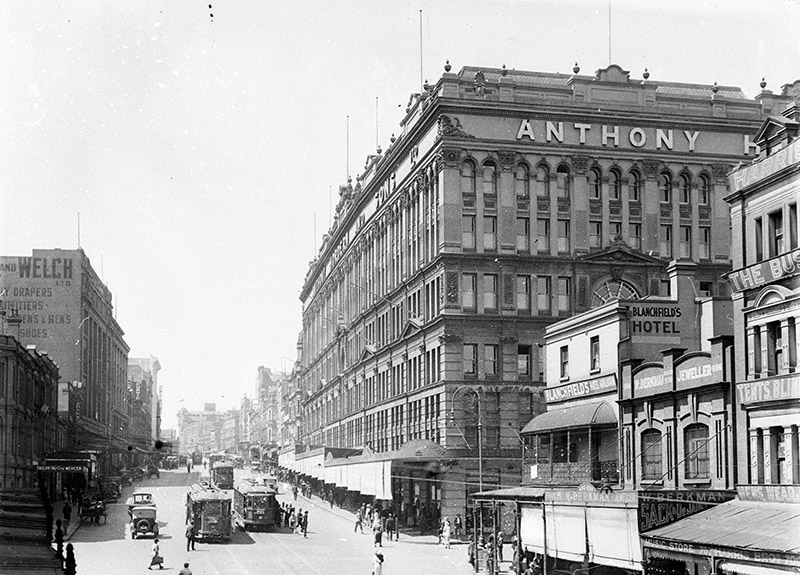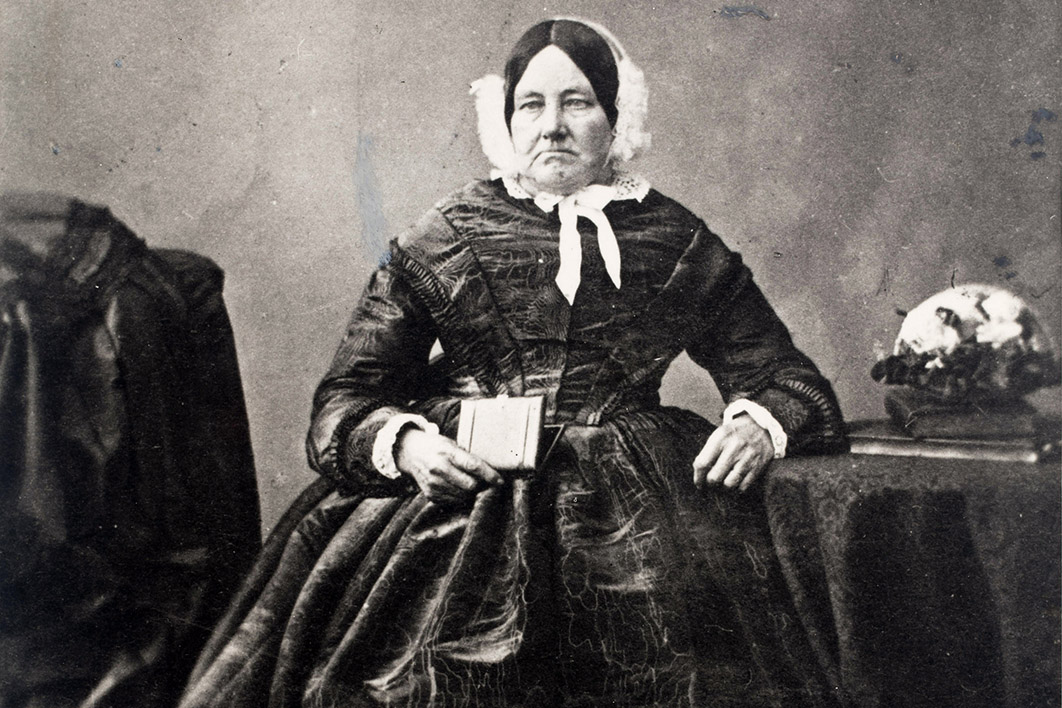Part of our collection of articles on Australian history’s missing women, in collaboration with the Australian Dictionary of Biography
Many readers will remember the imposing edifice of the Anthony Hordern & Sons department store, which until 1986 covered a whole block in Sydney’s Haymarket. Although it bore her husband’s name, this highly successful retail operation was founded by Ann Hordern after her arrival from Britain in 1825.
The former Ann Woodhead emigrated as a free settler with her husband Anthony and their four young children aboard the Phoenix. After the vessel docked, Ann penned a letter to her parents back in England for delivery on the return voyage. During her first trip ashore, though, she saw that the well-dressed ladies of Sydney Town followed the latest fashions and had the means to pay for them. She returned to the boat and quickly added a postscript to her letter, with a request.
“I wish we had about £10 of your goods that I might begin in a little way,” she wrote. “We shall endeavour to sell some of our things and save a little if we can and buy some wool to send you to sell for us, send the return in stays… Cotton ginghams, prints, muslins, and lace are very dear, checked shirts and silk slops and waistcoats fetch a great price… Bonnet shapes, ribbons and sewing silks as well. I wish you could be so kind as to trust us £10 or £20 of [each] at cost price. We will endeavour to send you over as much wool as in our power for you to sell and pay for the goods with.”
Ann had sized up the women accurately. “The stays,” she said, “must be from 24 to 30 inches… and more 27 and upwards as women run large.” Astute and quick-witted, she had also grasped her family’s prospects, reporting to her parents that “if people strive, they may get a living middling comfortably.”
Ann had learned the trade from her father, a London bonnetmaker and staymaker originally from Retford, Nottinghamshire. Intelligent and well educated, she had developed into a stubborn, strong-willed businesswoman. Her husband, on the other hand, was a mild-mannered and relatively uneducated wheelwright and coachmaker.
Not wasting any time, Ann announced in the Sydney Gazette on 14 July 1825 that her business had begun: “Mrs Hordern, Long Stay and Corset Maker, Whalebone Manufacturer, from London, begs Leave to acquaint the Ladies, that she has commenced Business at No. 2. Upper Pitt-street, Sydney,” which is now at the northeast corner of Pitt and Campbell Streets. “Stays, made to Order, on the shortest notice, and in the most fashionable way, on reasonable terms; an assortment of Stays ready-made. Staymakers supplied with Whalebone, ready dressed.”
Her trade flourished and she continued to post six-monthly advertisements. By January 1827, with the arrival of the goods ordered from her parents, she had progressed from staymaking to running a general drapery warehouse. In March that year, she advertised her growing range of merchandise: “More Bargains are now on sale at Mrs HORDERNS… consisting of a Variety of good large size twilled Shawls, only 4s. 6d. to 5s. 6d. Sterling each, figured silk scarves from 9s. Sterling and upwards, prints, muslins, and a numerous assortment of other Articles, are now on Sale.”
With her developing business, she already needed to employ staff, advertising for “Two or Three respectable Young GIRLS, from the Age of 11 to 13 Years, are wanted to learn the Staymaking Business.”
During the economic downturn that probably closed her first shop in 1828, Ann may have assisted her husband in running the Coachmaker’s Arms tavern, which he had opened in George Street. A trader at heart and by experience, she is thought to have also run a stall opposite the tavern.
By 1830, however, she was again in business, this time in a reopened shop at 17 King Street, near Castlereagh Street. Here she specialised in the sale of bonnets. She accompanied an advertisement in the Sydney Herald in April 1834 for her “Splendid Stock of Ladies’ and Children’s Tuscan Bonnets” with a filled-in line drawing of a bonnet — the first illustration of its kind to be published in Australia, making her a pioneer in fashion-plate advertising.
This “BARGAINS IN BONNETS” advertisement listed her increased range of merchandise, including leghorn and beaver hats, coloured stays, cloth cloaks, umbrellas, “Ladies’ best French Kid Gloves,” handkerchiefs, boots and shoes. Over the years, her stock steadily diversified: silks and laces and “furs such as sable, chinchilla, squirrel fitch mynx &c &c” replaced the loose, thin outer garments called “slops” and the “calicoes” of 1825.

Anthony Hordern & Sons, 569–700 George Street, Sydney, c. 1924–25. The building was controversially demolished in 1986. Home and Away Collection/State Library of New South Wales, 35121
Ann and Anthony had moved to larger premises at 12 King Street in 1836. Two years later, Anthony gave up both the tavern and his coachmaking business to join his wife in her drapery store. When a neighbour saw Anthony cleaning the windows and washing down the shop, he mistook him for Ann’s assigned convict.
The Horderns soon started buying up land in what are now the central business districts of Melbourne and Sydney, generously helping set up their sons with a residence and shop each, and their daughter Elizabeth and her husband in business. Again, Ann seems to have been the progenitor of this decision. From the profits that had flowed from her business, Anthony was able to move in social status from a working-class tradesman to a middle-class landowner.
Ann remained the dominant partner in both domestic and business affairs. When Anthony joined Ann at her store, however, the name became “Anthony Hordern” — the first retail store of that name. It was to become synonymous with the huge commercial retailing business that, in the words of the Bulletin, “rule[d] the retail trade of the metropolis and the colony in general.”
While Ann Hordern was working to support her family from 1825 to 1838, she also bore six more children. Two sons died in infancy, as did one of the sons who came with her and Anthony from England. A devoted mother, she was also an organising one — even after her children had set up their own businesses.
Forthright and hardworking, sometimes hot-tempered, Ann Hordern was a remarkable woman who exhibited toughness and initiative. In her book Children of One Family, Lesley Hordern — the wife of Marsden Hordern, a descendant — identifies Ann as “the driving force behind her family’s commercial ventures and their subsequent considerable achievements.” She had recognised the business possibilities of early Sydney and grasped the opportunity to invest in inner-city land. Her legacy was the foundation of the “Anthony Hordern” tradition that her sons and their descendants were to follow.
Ann Hordern died on 18 January 1871, aged seventy-nine, at Retford Hall, the family mansion her son Anthony had named after her hometown in Nottinghamshire. Nottingham House (situated on land purchased for son John in George Street, Sydney) similarly honoured her.
Ann’s male descendants have been acknowledged in at least twelve National Centre of Biography entries. It is now time for Ann Hordern, the founder of the “Anthony Hordern & Sons” dynasty, to be given her well-deserved place in the sun. •
Further reading
Children of One Family: The Story of Anthony and Ann Hordern and Their Descendants in Australia 1825–1925, by Lesley Hordern, Retford Press, 1985
Minding Her Own Business: Colonial Businesswomen in Sydney, by Catherine Bishop, NewSouth Books, 2015
Shopkeepers and Shoppers: A Social History of Retailing in New South Wales from 1788, by Frances Pollon, Retail Traders’ Association of New South Wales, 1989




